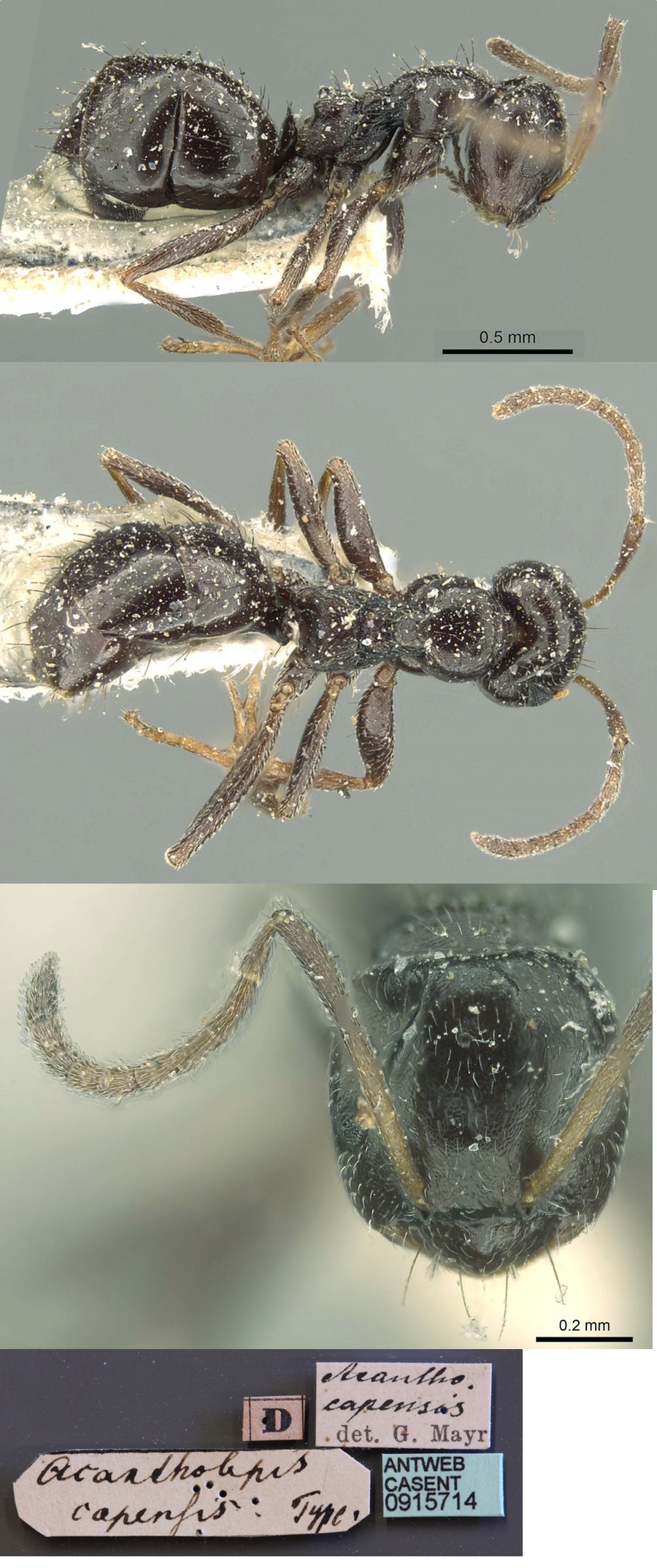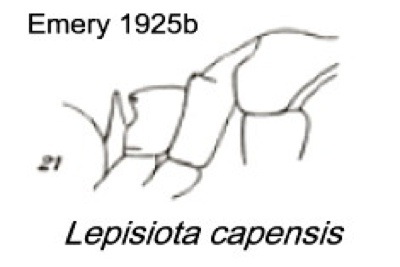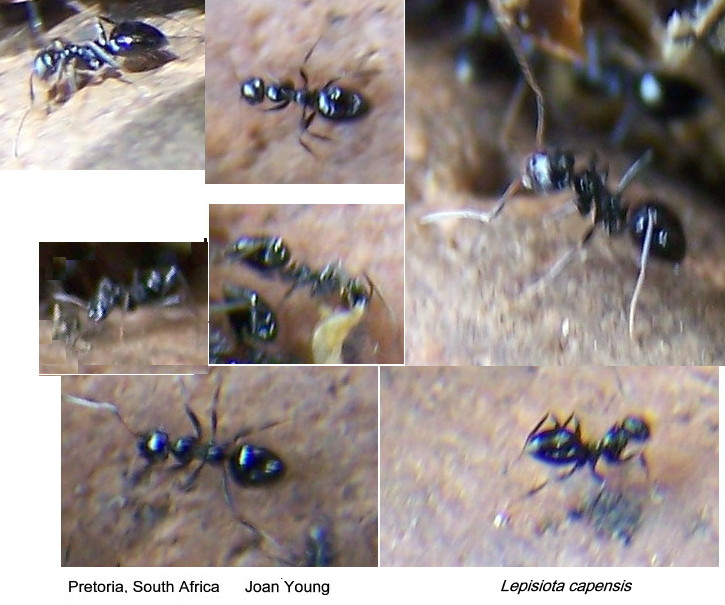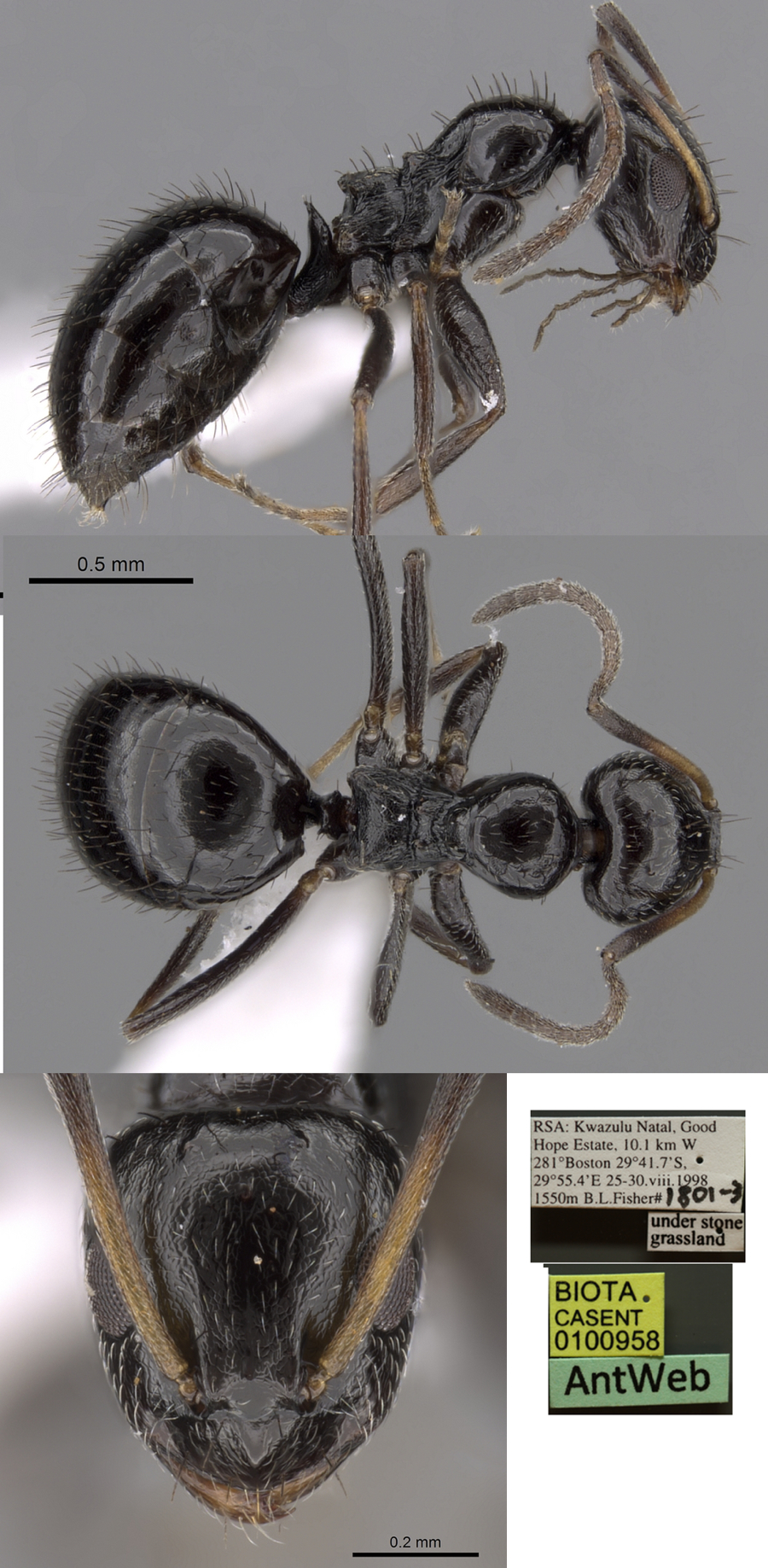Lepisiota capensis (Mayr) revised status
  Type location South
Africa (Acantholepis capensis n. sp., Mayr, 1862: 699,
worker; Mayr, 1862: 770, male; also Mayr, 1866: 57, male; Emery, 1877b:
366, queen) - see below Type location South
Africa (Acantholepis capensis n. sp., Mayr, 1862: 699,
worker; Mayr, 1862: 770, male; also Mayr, 1866: 57, male; Emery, 1877b:
366, queen) - see below
Junior synonym subopaciceps (Acantholepis
capensis Mayr v. subopaciceps
n. v., Santschi, 1937d: 235, worker; synonymy here) from Angola,
Kangela, Monard - see http://www.antweb.org/specimenImages.do?code=casent0912375
see Bolton (1995) and also Bingham (1903: 316) and Arnold (1920a: 568)  . .
|
 Mayr's
(1862) brief description is at Mayr's
(1862) brief description is at  , Mayr (1865: 57) gave a full description
of the worker, plus that of the male, and illustrations, these are at , Mayr (1865: 57) gave a full description
of the worker, plus that of the male, and illustrations, these are at  . Emery's (1877b) description of the queen
is at . Emery's (1877b) description of the queen
is at  , Arnold (1920a) provided a translation of
Mayr's (1862) description with a fuller description of his (Arnold)
own, this is at , Arnold (1920a) provided a translation of
Mayr's (1862) description with a fuller description of his (Arnold)
own, this is at  . .
Mayr (1865) and Arnold (1920a) gave the size as TL
2.8-3.2 mm; the scape surpassing the occiput by about one-third their
own length.
Santschi's (1937d) description of subopaciceps
is at  . TL not given; appears
to have a matt
appearance, with quite strong reticulation on head; petiole scale less
strongly incised than validiuscula; rectilinear toward summit. . TL not given; appears
to have a matt
appearance, with quite strong reticulation on head; petiole scale less
strongly incised than validiuscula; rectilinear toward summit.
|
 The photomontage of a type worker is collated from http://www.antweb.org/specimen.do?name=casent0915714. The photomontage of a type worker is collated from http://www.antweb.org/specimen.do?name=casent0915714.
|
  Re-definition
of true capensis Re-definition
of true capensis
There seems little doubt that the true type form has the propodeum with
quite pronounced blunt prominences; the petiole scale is only moderate
in height and has low spines on the dorsal margin. The overall
appearance is near black and shiny, with the antennae wholly brown or
blackish. The pilosity is short, dark and fairly sparse.
See also the note on true capensis, i.e. from
the Cape of Good Hope, by Emery (1897e) in his description of canescens
-  . Santschi (1937d) noted the capensis
type has antenna which are entirely brown or blackish. . Santschi (1937d) noted the capensis
type has antenna which are entirely brown or blackish.
Some of the confusion may stem from Forel (1892a: 43)
where his key had - capensis (from South Africa, Madagascar and
Indian continent) with the erroneous "erect pilosity whitish, abundant
on body, none
on tibiae and scapes".
The photograph right is of Lepisiota capensis
from Cape Town, South Africa, and is from one of three superb Myrmecos.net
originals taken by Alex Wild.
|
Oxford University Museum
specimens
Lepisiota capensis
B Taylor det.
|
South Africa
S Danflous
|
14.xii.2007
Nelspruit
25°28'50" S
30°58258" E
|
Backpackers,
Mpumalanga Province; 283 m
|
2
|
 |
Lepisiota capensis
B Taylor det. |
South Africa
S Danflous
|
6.xii.2007
Sudwala Caves
25°22'09" S
30°41'58" E
|
Gaufeng Province;
166 m
|
1
|
 |
Lepisiota capensis
B Taylor det. |
South Africa
KZ Natal
P. Jaloszynski
|
03.xii.2012
27.53154° S
32.66992'E
|
Sodwana bay, swamp
forest
5 m
Under bark
|
4
|
 |
Lepisiota capensis
B Taylor det. |
Zimbabwe
S Renner
SB 05
|
vii.2012
Harare
17°51’50" S
31°01’47" E
|
Visiting flowers of
an Apodanthaceae
|
1
|
 |
Lepisiota capensis
B Taylor det. |
Zimbabwe
S Renner
SB 06
|
vii.2012
Harare
17°51’50" S
31°01’47" E
|
Visiting flowers of
an Apodanthaceae
|
1
|
 |
|
 The
photomontage is
of a worker collected from South
Africa,
Nelspruit; collector Sam
Danflous,. The
photomontage is
of a worker collected from South
Africa,
Nelspruit; collector Sam
Danflous,.
TL ca 2.8 mm, HL 0.73 HW 0.65 EL 0.23 PW 0.49 SL
0.70 CI 92 SI 130
|
 The
photomontage is
of a second worker from
South Africa, Sudwala Caves, Gaufeng Province; collector Sam
Danflous, 6.xii.2007. The
photomontage is
of a second worker from
South Africa, Sudwala Caves, Gaufeng Province; collector Sam
Danflous, 6.xii.2007.
TL ca 2.8 mm, HL 0.73 HW 0.65 EL 0.23 PW 0.49 SL
0.70 CI 92 SI 130
|
 The
photomontage is
of a worker collected from Zimbabwe,
Harae; collector S Renner. The
photomontage is
of a worker collected from Zimbabwe,
Harae; collector S Renner.
|
 The
specimens in these field photographs, feeding group below, were taken
in Pretoria, South Africa, by Joan Young; nos 100_6382 to 6385. The
specimens in these field photographs, feeding group below, were taken
in Pretoria, South Africa, by Joan Young; nos 100_6382 to 6385.
|
 Feeding activity, Joan Young. Feeding activity, Joan Young.
|
 The photomontage of a worker from South Africa, collated from http://www.antweb.org/specimen.do?name=casent0100958 The photomontage of a worker from South Africa, collated from http://www.antweb.org/specimen.do?name=casent0100958
|
|